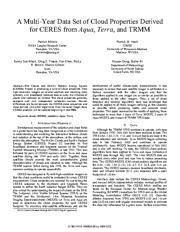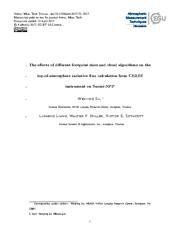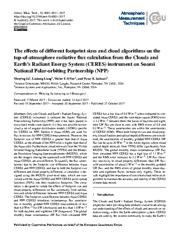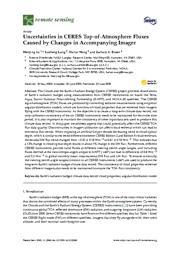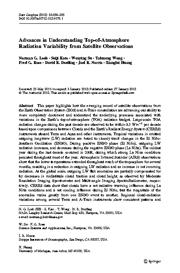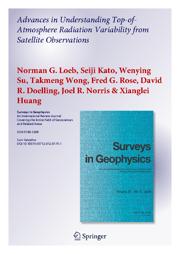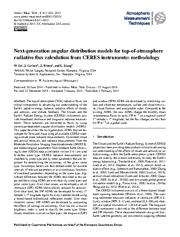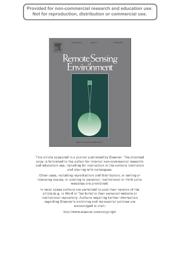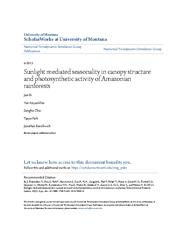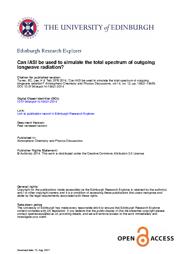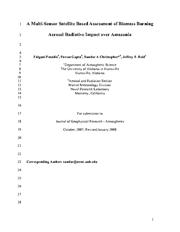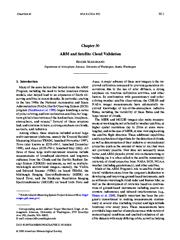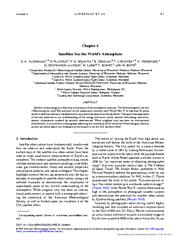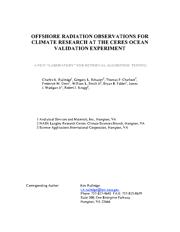A copy of this work was available on the public web and has been preserved in the Wayback Machine. The capture dates from 2017; you can also visit the original URL.
The file type is application/pdf.
Filters
A Multi-Year Data Set of Cloud Properties Derived for CERES from Aqua, Terra, and TRMM
2006
2006 IEEE International Symposium on Geoscience and Remote Sensing
The Clouds and Earth's Radiant Energy System (CERES) Project is producing a suite of cloud properties from high-resolution imagers on several satellites and matching them precisely with broadband radiance ...
Distinct differences are found between the CERES cloud properties and those derived with other algorithms from the same imager data. CERES products will be updated beginning in late 2006. ...
This paper summarizes the results of applying those techniques to more than 5 years of Terra MODIS, 3 years of Aqua MODIS, and 4 years of TRMM VIRS data.
II. ...
doi:10.1109/igarss.2006.460
dblp:conf/igarss/MinnisHSTCBGDX06
fatcat:qapzo3dznrh2pkiooi4z4rcqfq
The effects of different footprint sizes and cloud algorithms on the top-of-atmosphere radiative flux calculation from CERES instrument on Suomi-NPP
2017
Atmospheric Measurement Techniques Discussions
The simulation is designed to isolate the effects of footprint size difference and cloud property difference on flux uncertainty from calibration difference between CERES-NPP and CERES-Aqua. ...
To quantify the flux uncertainties due to the footprint size difference between CERES-Aqua and CERES-NPP, and due to both the footprint size difference and cloud property difference, a simulation is designed ...
Acknowledgments.
318 This research has been supported by the NASA CERES project. The authors thank 319 Norman Loeb and Patrick Minnis for helpful discussions. ...
doi:10.5194/amt-2017-75
fatcat:rja32h542va2jcy6gmughiiosu
The effects of different footprint sizes and cloud algorithms on the top-of-atmosphere radiative flux calculation from the Clouds and Earth's Radiant Energy System (CERES) instrument on Suomi National Polar-orbiting Partnership (NPP)
2017
Atmospheric Measurement Techniques
is thus not possible to construct a set of angular distribution models (ADMs) specific for CERES on NPP. ...
The simulation is designed to isolate the effects of footprint size and cloud property differences on flux uncertainty from calibration and orbital differences between NPP CERES and Aqua CERES. ...
We thank Norman Loeb, Szedung Sun-Mack, Qing Trepte, and Patrick Minnis for helpful discussions, and the three reviewers for their constructive comments and suggestions which have significantly improved ...
doi:10.5194/amt-10-4001-2017
fatcat:q7cuk6j7drcv5bauvbhu4pyhze
Uncertainties in CERES Top-of-Atmosphere Fluxes Caused by Changes in Accompanying Imager
2020
Remote Sensing
The Clouds and the Earth's Radiant Energy System (CERES) project provides observations of Earth's radiation budget using measurements from CERES instruments on board the Terra, Aqua, Suomi National Polar-orbiting ...
the consistency of other input data sets used to produce this climate data record. ...
Acknowledgments: This research has been supported by the NASA CERES project. The CERES datasets were obtained from http://ceres.larc.nasa.gov/order_data.php. ...
doi:10.3390/rs12122040
fatcat:ueseebgoivbdfmxkc3s3c4vndi
Advances in Understanding Top-of-Atmosphere Radiation Variability from Satellite Observations
2012
Surveys in geophysics
CERES data show that clouds have a net radiative warming influence during La Niña conditions and a net cooling influence during El Niño, but the magnitude of the anomalies varies greatly from one ENSO ...
Terra and Aqua and other instruments. ...
CERES SSF1deg-lite_Ed2.5 data were obtained from http://ceres.larc.nasa.gov/compare_products.php. ...
doi:10.1007/s10712-012-9175-1
fatcat:sbmgslgtxfhkdhqe6metxxcm3i
Advances in Understanding Top-of-Atmosphere Radiation Variability from Satellite Observations
[chapter]
2012
Space Sciences Series of ISSI
CERES data show that clouds have a net radiative warming influence during La Niña conditions and a net cooling influence during El Niño, but the magnitude of the anomalies varies greatly from one ENSO ...
Terra and Aqua and other instruments. ...
CERES SSF1deg-lite_Ed2.5 data were obtained from http://ceres.larc.nasa.gov/compare_products.php. ...
doi:10.1007/978-94-007-4327-4_4
fatcat:d6h53fgjevg3rm47eyq4phi2bq
Next-generation angular distribution models for top-of-atmosphere radiative flux calculation from CERES instruments: methodology
2015
Atmospheric Measurement Techniques
This paper describes the next-generation ADMs that are developed for Terra and Aqua using all available CERES rotating azimuth plane radiance measurements. ...
Over clear ocean, we developed a set of shortwave (SW) ADMs that explicitly account for aerosols. ...
The authors thank Norman Loeb, Patrick Minnis, Sunny Sun-Mack, Walter Miller, Natividad Monalo-Smith, Constantine Lukashin, Seiji Kato, and Qing Trepte for helpful discussions. Edited by: S. Schmid ...
doi:10.5194/amt-8-611-2015
fatcat:oaxzzxhprjagbi4m2web6cbqfa
Introduction to remote sensing
1997
ChoiceReviews
The spatial and temporal characteristics of dust aerosols and their properties are assessed from satellite and ground-based sensors. ...
DRE for LP is likely more negative due to fall out of larger particles during transport from CV to LP. However, separating the CERES-derived DRE by MODIS aerosol effective radii was difficult. ...
The data were obtained through the NASA Langley Distributed Active Archive Systems and other data sets. ...
doi:10.5860/choice.34-3870
fatcat:bttgnb3vxrfh5jslyrbjshopgm
Satellite and surface-based remote sensing of Saharan dust aerosols
2010
Remote Sensing of Environment
The spatial and temporal characteristics of dust aerosols and their properties are assessed from satellite and ground-based sensors. ...
DRE for LP is likely more negative due to fall out of larger particles during transport from CV to LP. However, separating the CERES-derived DRE by MODIS aerosol effective radii was difficult. ...
The data were obtained through the NASA Langley Distributed Active Archive Systems and other data sets. ...
doi:10.1016/j.rse.2009.12.007
fatcat:4ouk45cgprakne6dsjhroxnbby
Sunlight mediated seasonality in canopy structure and photosynthetic activity of Amazonian rainforests
2015
Environmental Research Letters
The authors declare no conflict of interest. ...
Author contributions J B, Y K, S C and T P performed the analyses. RBM wrote the initial draff. All authors contributed with ideas to the analyses and with writing the article. ...
This methodology is applied to transform standard BRF products from Terra and Aqua MODiS observations [ figure S3 [a]], in the case of MiSR, the algorithm is applied to each MiSR cam era to derive cam ...
doi:10.1088/1748-9326/10/6/064014
fatcat:2wcsuscj6ngdddazdewmbnm3zu
Can IASI be used to simulate the total spectrum of outgoing longwave radiation?
2014
Atmospheric Chemistry and Physics Discussions
Total integrated all-sky radiances are validated with broadband measurements from the Clouds and the Earth's Radiant Energy System (CERES) instrument on the Terra and Aqua satellites at simultaneous nadir ...
A new method of deriving high-resolution top-of-atmosphere spectral radiances over the entire outgoing longwave spectrum of the Earth is presented. ...
CERES and IASI data was provided by NASA and EUMETSAT. We thank N. Loeb for valuable comments. ...
doi:10.5194/acpd-14-18421-2014
fatcat:lms4rgznzjarxgnjzbiv7si6b4
A Multisensor satellite-based assessment of biomass burning aerosol radiative impact over Amazonia
2008
Journal of Geophysical Research
1 2 Using spatially and temporally collocated multi-spectral, multi-angle and broadband data 3 sets from the Terra satellite, the role of biomass burning (BB) smoke particles on cloud-4 free top of atmosphere ...
This is the 18 first multi-year assessment of SWARF for biomass burning aerosol particles using 19 satellite observations alone and should serve as a useful constraint for numerical 20 modeling simulations ...
Ward (1998), An overview of GOES-8
(2003), CERES Cloud Property Retrievals from Imagers on TRMM, Terra, and Aqua.,
Sensing of Clouds and the Atmosphere VII, Barcelona, Spain, September 8-12, ...
doi:10.1029/2007jd009486
fatcat:jbnt2fu4t5aodmea6tvjj3i4wm
ARM and Satellite Cloud Validation
2016
Meteorological Monographs
Figure 30 -4 shows scatterplots of microphysical properties for the Terra overpasses for this restricted set. ...
Two separate satellite retrievals (one derived from MODIS data by the MODIS Atmospheres Team and one derived from MODIS data by the CERES Science Team) were compared with results from two ground-based ...
doi:10.1175/amsmonographs-d-15-0038.1
fatcat:od5ib4kchng4pcpr732gnpvkta
Satellites see the World's Atmosphere
2018
Meteorological Monographs
In less than 70 years, satellite observations have transformed the way scientists observe and study Earth. ...
Satellite meteorology is a relatively new branch of the atmospheric sciences. The field emerged in the late 1950s during the Cold War and built on the advances in rocketry after World War II. ...
The authors are thankful for the comments, resources, and suggestions provided by S. Stephens. The authors also appreciate and thank the thoughtful comments by reviewers. ...
doi:10.1175/amsmonographs-d-18-0009.1
fatcat:hillp6ewefh5rpcvcv22nnhcca
Offshore Radiation Observations for Climate Research at the CERES Ocean Validation Experiment: A New "Laboratory" for Retrieval Algorithm Testing
2006
Bulletin of The American Meteorological Society - (BAMS)
The relatively low and homogeneous surface albedo of the ocean make this type of site a simpler environment for observing and validating radiation parameters from satellite-based instruments. ...
A new surface observation project called the CERES Ocean Validation Experiment (COVE), operating on a rigid ocean platform, is supplying data to validate some of these instruments and retrieval products ...
the planet on several of NASA's Earth Observing System (EOS) of satellites (TRMM, TERRA, and AQUA). ...
doi:10.1175/bams-87-9-1211
fatcat:opcc7lheb5d5tiaapgxn73i2ri
« Previous
Showing results 1 — 15 out of 103 results

